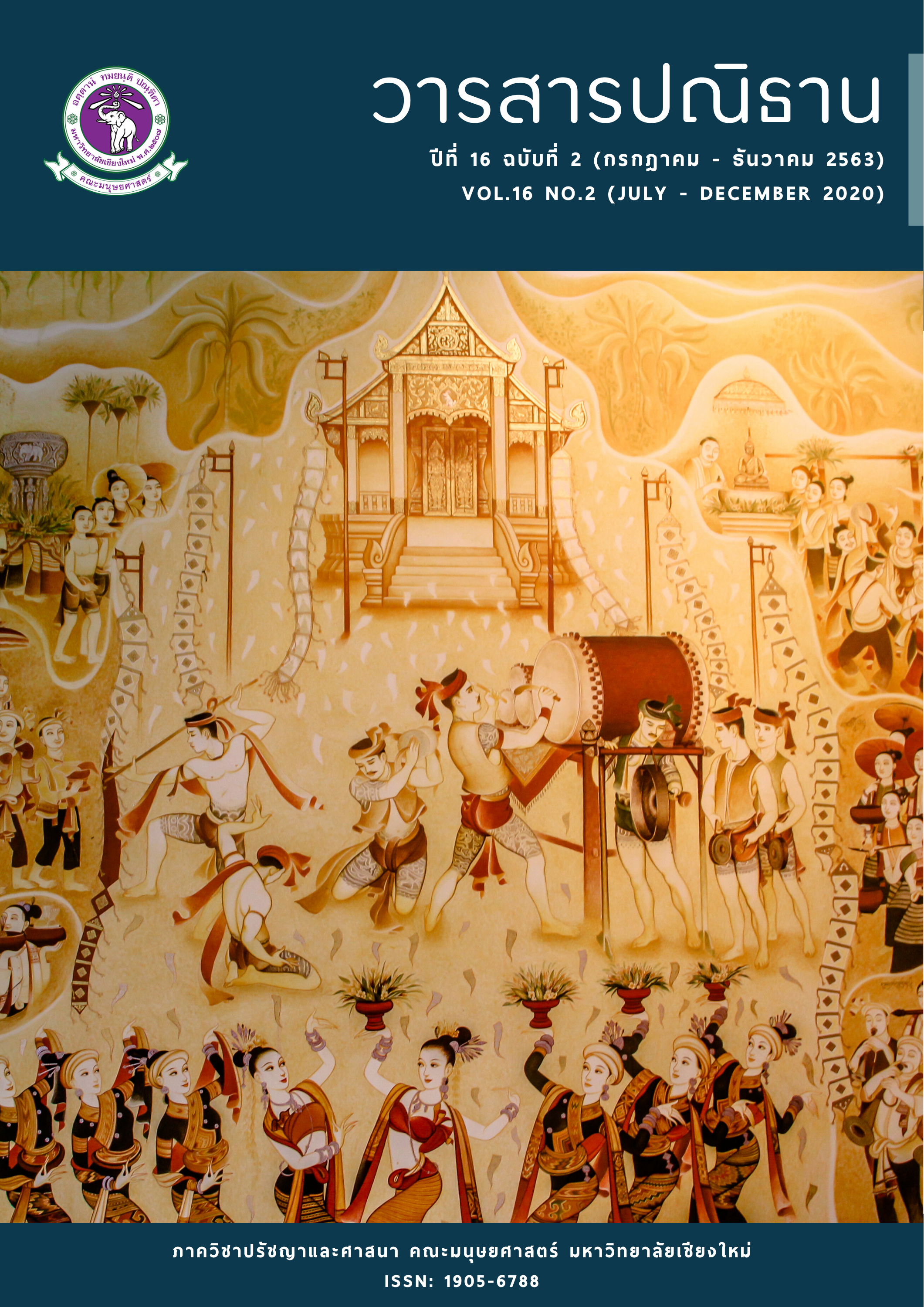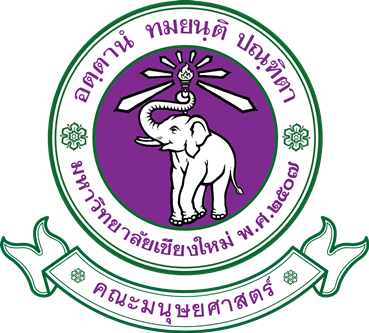"จอย" ความเป็นมนุษย์ที่ดำรงอยู่โดยปราศจากร่างกาย: บทวิเคราะห์ผ่านแนวคิดปรากฏการณ์วิทยาของมอริช แมร์โล-ปองตี
คำสำคัญ:
มอริช แมร์โล-ปองตี, การดำรงอยู่โดยปราศจากร่างกาย, ปรากฏการณ์วิทยา, เบลดรันเนอร์ 2049บทคัดย่อ
บทความนี้เป็นการนำเสนอต้นตอของปัญหาการแบ่งแยกกายและจิตหนึ่งในปัญหาสำคัญเริ่มต้นที่เรอเน่ เดส์การ์ตส์ที่นำเสนอแนวคิด I think, therefore I am ทำให้มนุษย์มองตนเองในฐานะสิ่งที่คิดได้และให้ความสำคัญกับจิตมากกว่ากาย อย่างไรก็ตาม ปัญหาเรื่องการยืนยันการดำรงอยู่ที่เดส์การ์ตส์เสนอโดยให้จิตสำคัญ เมื่อเทียบกับกายส่วนของประสาทสัมผัสอันเป็นส่วนประกอบขั้วหนึ่งของการดำรงอยู่ที่เขามองว่าเป็นส่วนที่ทำให้เกิดข้อผิดพลาด ทำให้ไม่สามารถยึดถือข้อมูลที่ผ่านเข้ามาทางประสาทสัมผัสได้ กายไม่สมบูรณ์เมื่อเทียบกับจิต จากนั้นผู้เขียนนำเสนอประเด็นที่ปองตีเสนอว่าการรับรู้ทางประสาทสัมผัสมีความสำคัญต่อการอธิบายการดำรงอยู่ของมนุษย์ การที่เรามีความสำนึกทางร่างกายเป็นตัวเชื่อมต่อระหว่างเรากับโลกและเราสัมพันธ์กับโลกในเชิงอิงอาศัย การมองกายตามแบบแมร์โล-ปองตีเสนอเป็นการมองกายในฐานะองค์ประธานที่เป็นรูปธรรมยิ่งกว่าจิต การเสนอว่ากายและจิตไม่ได้แยกออกจากกันจึงเป็นข้อเสนอน่าสนใจ และพิจารณา จากการที่แมร์โล-ปองตีให้ความสำคัญกับกาย คำถามน่าสนใจคือหากมีการดำรงอยู่แบบปราศจากกาย เราจะกล่าวว่าการดำรงอยู่เช่นนั้นเป็นมนุษย์ได้หรือไม่ บทความนี้จึงนำจอยในภาพยนตร์เบลดรันเนอร์ 2049 วิเคราะห์ผ่านแนวคิดปรากฏการณ์วิทยาของแมร์โล-ปองตี เนื้อเรื่องของภาพยนตร์ จอยเป็นโฮโลแกรมที่พยายามกระทำและแสดงออกถึงการเป็นมนุษย์ที่แท้จริง พบว่าจอยที่มีอยู่โดยปราศจากกายไม่สามารถดำรงอยู่ในฐานะมนุษย์ได้ตามแนวคิดปรากฏการณ์วิทยาของแมร์โล-ปองตี เนื่องจากจอยดำรงอยู่เป็นโฮโลแกรมไม่มีร่างกาย ประกอบกับจอยเองเป็นสิ่งถูกสร้างที่ไร้สำนึกทำให้จอยขาดตัวเชื่อมต่อระหว่างโลกและตัวจอย จึงส่งผลให้ไม่สามารถเกิดการเรียนรู้ในการมีอยู่แบบมนุษย์และไม่มีสำนึกทั้งต่อตนเองและสภาพแวดล้อม
เอกสารอ้างอิง
Bluden, A. (n.d.). Mediations On First Philosophy in which are demonstrated the existence of God and distinction between the human soul and body. Retrieved 18 May 2020, from https://www.marxists.org/reference/archive/descartes/1639/meditations.htm
Bullock, P. (2017). Perception and Reality in Blade Runner 2049. Retrieved 30 May 2020, from https://medium.com/@pbullockuk/perception-and-reality-in-blade-runner-2049-9a605810a519
Carman, T. (2008). Merleau‐Ponty. NY: Routledge Press.
Greetham, B. (2006). Philosophy. Basingstoke [England]; NY: Palgrave Macmillan.
Jackson, G. B. (2016). Maurice Merleau-Ponty’s concept of motor intentionality: Unifying two kinds of bodily agency. European Journal of Philosophy, 26(2),1-12.
Kosove, A. A., Johnson, B., Yorkin, B., & Yorkin. C. A., (2017). Blade Runner 2049 [Motion picture]. United State of America: Columbia Picture.
Ly, A. (2018). Blade Runner 2049: Why Joi Was The Best Addition To The Franchise. Retrieved 22 May 2020, from https://www.andrewjly.com/blog/2018/1/4/blade-runner-2049-character-series-why-joi-was-the-best-most-interesting-addition-to-thefranchise?fbclid=IwAR0dkN8VGAJewUl4jMfUlWXcx07EYDuDhzudNb5jH8eGSKQiBZ0NsDUFMI
Merleau‐Ponty, M. (2012). Phenomenology of perception. (D. Landes, Trans.). NY: Routledge.
Mlinar, I. A. (2015). Phenomenology as an Approach Method in the Neurosciences. Psychiatryand Neuroscience Update, 11-22.
Moya, P. (2014). Habit and embodiment in Merleau-Ponty. Frontiers in Human Neuroscience, 9,1-3.
My conversation with an AI sexbot. Retrieved 23 May 2020, from https://www.youtube.com/watch?v=5pKczGG19uoNeuroscience.
Paul, A. B. (n.d.). Phenomenology. Retrieved 15 May 2020, from https://www.brown.edu/Departments/Joukowsky_Institute/courses/architecturebodyperformance/1065.html
Petrakovitz, C. (2017). Your 'Westworld' sexbot is almost here, thanks to RealDoll. Retrieved 23 May 2020, from https://www.cnet.com/news/realdoll-harmony-ai-app-realbotix-sexbot/
Reynolds, J. (n.d.). Maurice Merleau-Ponty’s. Retrieved 26 May 2020, from https://www.iep.utm.edu/merleau/
Social robots have finally arrived. Retrieved 23 May2020, from https://vimeo.com/347251203
The Blade Runner Wiki. Retrieved 22 May 2020, from https://bladerunner.fandom.com/wiki/Main_Page
Thitipattakul, P. (n.d.). เปิดตัว Social Robot หุ่นยนต์ AI ที่แสดงอารมณ์ได้คล้ายมนุษย์. สืบค้นเมื่อ 23 เมษายน 2563, จาก https://www.disruptignite.com/blog/social-robot-ai-that-can-express-emotion-like-human
Toadvine, T. (2016). Maurice Merleau-Ponty. Retrieved 19 May 2020, from https://plato.stanford.edu/entries/merleau-ponty/
Westphal, J. (2019). Descartes and the Discovery of the Mind-Body Problem. Retrieved 19 May 2020, from https://thereader.mitpress.mit.edu/discovery-mind-body-problem/
What is neuroscience?. Retrieved 21 May 2020, from https://www.kcl.ac.uk/neuroscience/about/what-is-neuroscience
ดาวน์โหลด
เผยแพร่แล้ว
รูปแบบการอ้างอิง
ฉบับ
ประเภทบทความ
สัญญาอนุญาต
เนื้อหาของบทความที่ได้รับการตีพิมพ์ในวารสารปณิธานถือเป็นลิขสิทธิ์ของวารสารปณิธาน ห้ามเผยแพร่ ตัดต่อ แก้ไข หรือนำไปใช้ก่อนได้รับอนุญาต
ผู้สนใจสามารถติดต่อขอเผยแพร่เนื้อหาในวารสารปณิธานได้ที่ panidhana-human@cmu.ac.th







